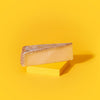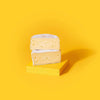Choosing your Cheddar
By Edward Hancock
Sep 15, 2021

Choosing your cheddar
Ask anyone in the world to name one cheese, and there is no doubt the most popular answer would be cheddar. It is the cheese that most of us, certainly in the UK, probably eat weekly, if not daily, and it is usually found sliced in a sandwich, or grated on a Jacket Potato.
But it is this popularity, or infamy, that has also led cheddar to becoming what many might consider a ‘boring’ cheese. Certainly, if a specialist cheesemonger decided to wax lyrical about the virtues of cheddar, you might feel short changed. “I know about cheddar, teach me something new.
Cheddar, in itself though, means nothing. It can refer to anything from sliced American processed cheese, through mass-produced block cheddar, all the way to traditional, clothbound, raw milk cheddar. So when many of us think we know our cheddar, how well do we really know it?
It won’t come as a surprise that the cheddar we focus on at cheesegeek is the latter…clothbound (generally), raw milk (often) traditional (always) cheddar. This isn’t because we are snobby (far from it, I regularly find myself chomping on a piece of Pilgrim’s Choice), but it’s because we don’t just love great cheese. We love great cheese with history, tradition and a story, and most of all that is an expression of the land that produced it. The soil, the grass, therefore the milk, and all those natural bacteria that mill around in the maturing rooms. It is all these things that make a cheese unique, and that make cheddars unique too. So rather than talk about ‘cheddar’ we prefer to talk about:
So, how to choose your cheddar?
If you take what we are saying, and they are all completely different, and unique, how do we go about deciding on which one is for us?
Well first of all, many of our customers like to ask for ‘the strongest cheddar you have, that will smash us in the face and make our taste buds tingle. One of those classic ‘5-mile’ cheddars that you can still taste 5-miles down the road. Well, if this is the case, it is really the maturity that is the major factor, and not the cheese itself. That lip-smacking tang, and cheddary bite, comes with time. And so all of our cheddars will develop those moody, aggressive flavours when left to age for 18 months plus (the ‘standard’ maturity will be around 1yr). So when you want that blistering bang, best to ask for a Vintage Cheddar. This should focus the cheesemonger on those 18 month or older cheddars.
Beyond that, how else do we decipher the options? For me personally here are my thoughts, that hopefully will guide your decision making!
Westcombe and Pitchfork
These two cheeses are made in Somerset, the historical home of cheddar. Along with Keen’s and Montgomerys, these are the only remaining traditional, clothbound, raw milk farmhouse cheddars still made in Somerset. Yes, just four!
Westcombe and Pitchfork are very much cheddar brothers, with Tom Calver at Westcombe and the Trethowan brothers at Pitchfork collaborating, and even sharing maturing space, over the years. The result is the cheddars both share similar characteristics. They are not the driest or most crumbly, and they have a slightly smoother finish. Whilst carrying that up front, farmy twang, this slightly more quickly gives way to a smooth buttery finish that I find delightful. These types of cheddar most suit my taste preference when it comes to cheddar.
Keen’s
Slightly drier than Westcombe and Pitchfork, and with more of an acidic bite, I always find Keen’s has more of a grassy/straw like taste to it, and it really does transport me to the Somerset countryside. It certainly delivers the taste bud tingle and grips the back of your throat, the signs of a ‘proper’ cheddar. When I eat Keen’s, I just can’t shake the feeling of walking through recently cut grass, speckled with dew, early on a Spring morning.
Montgomery’s
Arguably the heavyweight of cheddar, and with an almost evangelical following, Montgomery’s is dry, crumbly and has a barnyard snap that arrives up front, and just keeps on going. Monty’s seems to harbour some blue moulds more often than other cheddars, and they actually add to that ‘raw/untamed’ flavour and trademark tang. Perhaps one of the reasons is that no concerted efforts have been made to eliminate them. Monty’s is unmistakable, and it is no wonder many people unwaveringly maintain it as their cheddar of choice.
Isle of Mull and St Andrews Farmhouse
For me, the sign of a great cheese is when you take that first bite, you are immediately transported to that tiny piece of land where the cheese was made. It is that sense of place, and connection with the land, that makes a cheese unique, and ‘true’. It is a sign that the cheesemaker has harnessed nature, and paid tribute to it in that single chunk of cheese on your plate, with minimal intervention or adaptation. Isle of Mull, and St Andrews Farmhouse both achieve this.
I remember first tasting St Andrews cheddar, and feeling as if I was walking up the path to the farm, surrounded by cows, manure and tractors. The mud squelching beneath my feet, and the smell of hay bales. Similarly with Isle of Mull, made along the harsh Scottish coastline, wind and salt from the sea, and the cows feed supplemented by whisky draff from the local distillery, all these flavours come through in the cheese, a true juggernaut. Malty, salty, bold, and unmistakably Isle of Mull. If you are looking for this sense of place when choosing your cheddar, it doesn’t get much better than these.
Hafod
And so to Wales, and arguably one of the great cheddars, remarkable in many ways, not least because it is organic, and also made from the milk of Ayrshire cows, a rarity given the popularity of the higher yielding Holstein Fresians. Ayrshire cows are a sturdy bunch, much better suited to the rugged coastal terrain of West Wales, and what they lose in yield, they make up for in quality of their milk, which is perfect for cheesemaking. The result is a depth of richness to Hafod that is perhaps most remarkable of all. It carries those classic cheddar notes, but never loses that buttery, creamy, indulgent background that forms such a balancing act, keeping the cheese so elegant and refined. Whilst this might not be the hardest hitting cheddar, it certainly carries as much complexity and hidden nuance as any other cheddar I have come across.
Lincolnshire Poacher
Finally, it would be remiss of me to depart without mentioning Lincolnshire Poacher, a cheddar/Comte hybrid, made by the Jones brothers. With links going back many decades with Hafod, their recipe includes a number of processes that would be found in a Comte make, and so whilst you get the farmy cheddar hit, the finish has all the nutty, buttery almost floral sweet joy of a Comte. If cheddar with bravado isn’t your thing, Poacher just might be.
And more cheddar...
There are of course many more cheddar style cheeses to be found in the UK, from Quickes (steeped in tradition) in Devon all the way to Sussex Charmer in West Sussex. Every single one of these cheeses mentioned are Farmhouse cheeses, and that really does mean something in the artisan cheese world. By choosing a farmhouse cheese, you know that the cheese is made with the milk of a single herd of cows grazing the very same land. This means the milk is travelling mere metres, if not feet, from the milking parlour to the cheese vat. So why is this important? Well first of all, it means that the cheese really is an expression of that patch of land. Milk gathered from all over the place cannot possibly achieve that of course. But it also means the milk will be subjected to the least possible disruption. The less a milk is sloshed (for lack of a better term!) about and in transit at ambient temperatures, the higher quality that milk will be. In fact, the milk is gravity fed (so not even pumps) to the cheese vats in many of these cases.
And of course, this also makes the milk more suitable for non-pasteurisation. Finally, being so close to the cows allows the cheesemaker to adapt his make depending on weather conditions, where the cows have been grazing etc. Another layer of precision that will make the cheese as perfect as it can be.
So, choosing our cheddar? Look for farmhouse, understand what maturity of cheese works for your palate, and then experiment with each cheddar I have listed here to get an idea of which works best for you. Even better, if you can taste a number of them side by side, it will really highlight the differences!
Disclaimer: this may make it hard to go back to Cathedral City ;)


